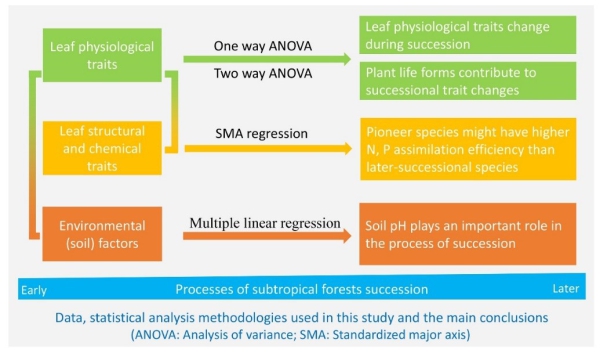Variations of leaf eco-physiological traits in relation to environmental factors during forest succession
Changes in leaf physiological traits and shifts in their relationships are expected to reveal plant ecological strategies during succession, and how they interact with the changing environment are thought to be useful in forest restoration and management. Although the relationships between leaf physiological traits and other structural and chemical traits have been studied on a global or regional scale, field experiments are also needed to further explore how these relationships vary along environmental gradients at finer scales.
Under the guidance of prof. REN Hai and others, HAN Taotao, the Ph.D student from South Botanical Garden of Chinese Academy of Sciences, investigated 9 physiological traits, 7 leaf structural and chemical traits of each dominant species across a successional series in southern China. Meanwhile, 14 environmental factors were also measured to identify which factors were most associated with leaf physiological traits along the successional gradients.
Results showed that leaf photosynthesis, respiration, transpiration, photosynthetic N-, and P-use efficiency decreased during succession, which could be explained by plant life forms. Changes in leaf physiological traits were associated with soil pH. Leaf nutrient-utilization strategies, interacting with soil pH, played an important role in the succession of subtropical forest. Soil pH could be used as an indicator of the process of forest dynamic succession in south China. This study can advance the understanding of plant survival and replacement strategies during forest succession.
This study entitled “Variations of leaf eco-physiological traits in relation to environmental factors during forest succession” was published in Ecological Indicators. For further reading, please refer to: https://doi.org/10.1016/j.ecolind.2020.106511.

File Download: